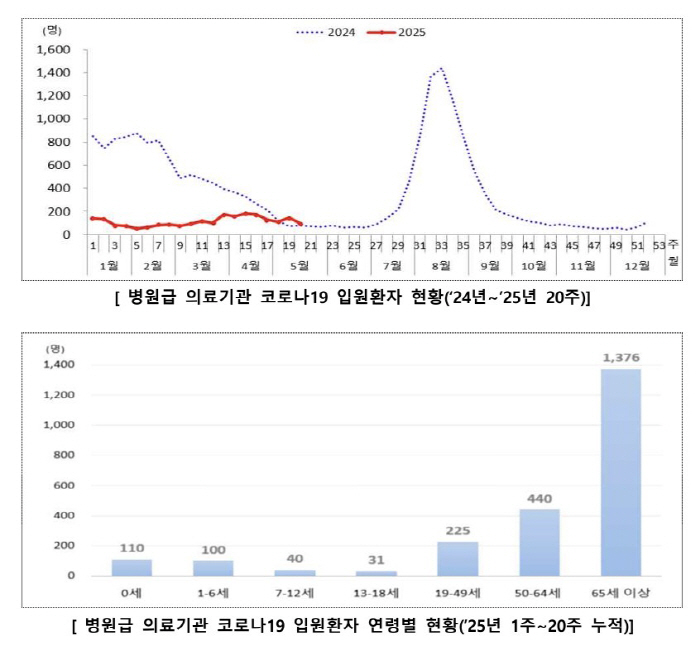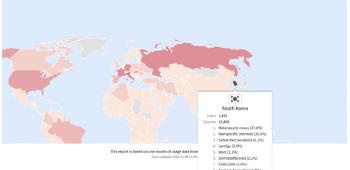The number of confirmed COVID-19 cases in Hong Kong, Taiwan, and Singapore continues to increase...Health authorities recommend vaccination for stable or high-risk groups in Korea
May 23, 2025
|
According to the World Health Organization's (WHO) announcement on the 4th, 23,164 patients were reported in 82 countries in the last four weeks (4.7. ~ 5.4), down from the previous four weeks (3.10. ~ 4.6, 46,269 in 91 countries). The positivity rate at week 18 was 3.4%, showing a continuous decline this year.
However, a rise in cases has been reported in neighboring countries such as Hong Kong.
Hong Kong, which had been on the rise since the 9th week (2.23 to 3.1) this year, reported 977 patients in the 20th week (5.11 to 17), a slight decrease from the previous week (1042), but the incidence is higher than the peak of last summer's epidemic (7.21 to 27), 796). The positivity rate was 13.80% in the 20th week, similar to the previous week (13.66%), but the highest in a year. The number of patients with severe COVID-19 (including death) was 27, up from the previous week (18).
Taiwan and Singapore are also showing an increase. Taiwan reported that the number of outpatient and emergency room visitors due to COVID-19 increased 91.3% from the previous week to 19,097 in the 20th week (5.11. ~ 5.17.), and most of the severe patients, including deaths this year, are aged 65 or older and chronically ill, and are unvaccinated with COVID-19. Singapore had 14,200 confirmed cases of COVID-19 in the 18th week (4.27. ~ 5.3.), up 27.9% from the previous week (11,100).
In China, the positive rate of COVID-19 among influenza doctors was 16.2% at week 18 (4.28. ~ 5.4.), continuing to increase from 7.5% at week 14 (3.31. ~ 4.6.). The China Centers for Disease Control and Prevention predicts that this summer's epidemic will not exceed last summer's level.
In the United States, the United Kingdom, and Japan, the positivity rate remains low at less than 5%. The COVID-19 positivity rate by country in the 19th week of this year was reported to be 2.9% in the United States, 5.0% in the United Kingdom, and 0.94 reports per Japanese monitoring agency.
Regarding the recent increase in the number of COVID-19 outbreaks in some foreign countries (Hong Kong, Thailand, etc.), the Korea Centers for Disease Control and Prevention recommended vaccination for high-risk groups as the possibility of summer epidemic cannot be ruled out considering previous years" he said.
According to the Korea Centers for Disease Control and Prevention, the number of COVID-19 hospitalized patients in domestic hospital-level medical institutions (221 sample monitoring institutions) in the 20th week of this year (5.11 to 17) was 100, down from the previous week (146), and it has been maintaining a similar level by repeating a slight increase and decrease over the past four weeks. By age, the age group aged 65 or older accounted for 59.3% (1376) of the total number of hospitalized patients this year.
The COVID-19 virus detection rate in the 20th week (5.11.-17.) was 8.6%, up from last week (2.8%), and sewage monitoring is also monitoring whether the increase continues as the virus concentration increases slightly (+3.6%p) compared to last week.
Omicron LP.8.1 accounted for the highest percentage of COVID-19 mutants in May (~5.17), while NB.1.8.1 of the XDV family, which has recently been prevalent in some countries, including Hong Kong, has continued to increase since its first detection in Korea in February this year, accounting for 21.2%. NB.1.8.1 showed a slight increase in immune avoidance ability compared to existing epidemic mutations, but its transmission power and severity have not yet been reported.
The Korea Centers for Disease Control and Prevention has extended the COVID-19 vaccination for high-risk groups from 2024 to 2025 season until June 30, including senior citizens aged 65 or older, immunocompromised people aged 6 months or older, and hospitalized and admitted to infectious facilities, and as of May 20, the vaccination rate for high-risk groups was only 47.4%, so it is highly recommended to vaccinate those who have not been vaccinated against COVID-19. The JN.1 vaccine currently in use is confirmed to be effective in preventing the immune response (neutralizing ability) that is still effective against the JN.1 variants such as XEC and LP.8.1, which are prevalent at home and abroad.
This article was translated by Naver AI translator.














